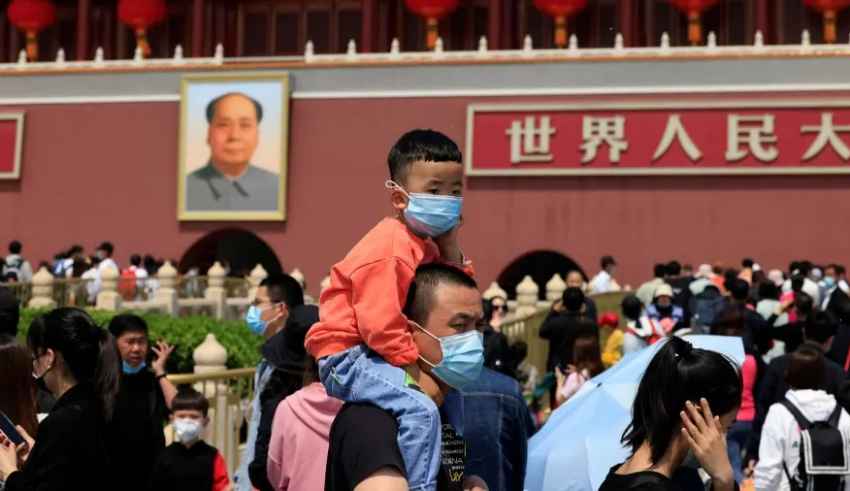
On the 31st of May 2021, China announced its 3-child policy in an attempt to address the challenges associated with it ageing population. The decision comes weeks after the release of the latest census results which predicts a rapidly ageing population and decreasing population of economically active (The Economist, 2021). Indeed, last year, China’s births fell to their lowest in almost six decades, which only threatens to compound the problem further. Will the change in policy be enough to reverse China’s demographic challenges?
The Effects of the One Child Policy
The one-child policy was implemented in 1979 amid growing concerns surrounding China’s population as it approached a billion and the effect this may have on government plans for economic growth (BBC, 2015). Although only in place for 36 years, the one-child policy in China is often considered one of the strictest family planning measures in the world and recognised as one of the ‘costliest lessons of misguided policymaking’ (Feng et al, 2016; 84) with huge demographic, social and economic ramifications for the whole of China. Many of the effects of the two-child and three-child policy are therefore based on the impacts of it antecedent.
In one sense, the policy did partly accelerate China’s economic development. For instance, it reduced women’s involvement in child rearing or motherly duties and was a considerable factor in China’s attainment of one of the highest female labour participation rates in the Asia-Pacific region (Asian Development Bank, 2017). Additionally, it facilitated an environment in which China could capitalise on a demographic dividend; an economic growth potential resulting from a change in lowering fertility rates and lowering dependency ratios (UNFPA, 2018).
However, it also led to, inter alia, complex long-term demographic implications. Perhaps the most notable demographic legacy of the one-child policy is its aggravated ageing population and increased dependency ratios. In addition to this, due to the cultural desire for boys the policy encouraged gender-biased sex selection (GBSS) and an imbalance in existing sex ratios. This distortion has led to a decrease in population and labour-force growth, distorted patterns of nuptiality and fertility, and increases in demands for the human trafficking of women (UNFPA, 2018). Indeed, the harmful implications of this policy were especially widespread, to which this article only touches the surface.
The Two-child Policy
The two-child policy was implemented in 2016, particularly in response to these threats of population ageing and resulting labour shortages (Zeng and Hesketh, 2016). Whilst it has only been in place for a few years, it has had a number of notable successes including significant declines in sex-selective abortion, improvements in unregistered births and a sex ratio that is now beginning to be less biased towards boys (Zeng and Hesketh, 2016). However, there is consensus that the long-term effects of this policy transition are likely to be less than anticipated and attempts to improve declining labour forces and mitigate the effects of population ageing will not be visible for roughly two decades. It is widely acknowledged amongst demographers and researchers that further policy is required.
For instance, socioeconomic factors have become a significant determinant in influencing fertility levels, rendering the two-child and three-child policy increasingly and substantially ineffective in achieving this desired outcome, especially in the short to medium term. Consequently, academics have therefore highlighted that further supplementary policies are required to better mitigate labour shortages and the social, health and caring requirements of an ageing population (Zeng and Hesketh, 2016).
Population Ageing & Labour Shortages
Whilst the consensus amongst academics is that it is too soon to predict how the two and three-child policy will affect fertility intentions or resolve the deviation from regular age-sex structures (Padmadas, 2017), demographers do not believe it will cause a reverse in population ageing (Padmadas, 2017). Additionally, further births will not aid labour shortages or population ageing until second or third new-born children reach economically active ages. However, whilst the labour force is expected to have an additional 60 million people by 2050, this is unlikely to meet the requirements of the economy (Zeng and Hesketh, 2016).
Under the two-child policy, research estimated that by 2030, the proportion of those aged over 65 will be 18% (Zeng and Hesketh, 2016), much less than if the one child policy had remained. Yet, this is still significant, and China’s rapid fertility transition means that unlike other countries it has limited time to adapt. Additionally, there is also a geographical dimension to this trend as this percentage roughly doubles for those living in rural areas (Zeng and Wang, 2014). Therefore, further policy must be implemented to mitigate the consequences associated with ageing and the health, social and care needs of the elderly from a regional perspective.
Strained Health and Community Care Systems
Currently, despite policies aimed at increasing provisions for the elderly such as the Rural Old Age Insurance Programme implemented in 2009, many elderly persons do not have complete pension provision and therefore rely heavily on their children for monetary support (Zeng and Hesketh, 2016)[1]. This burden is high for the predominantly 4:2:1 family, who must look after their one child and four parents. Health-care systems are also currently inadequate to meet the ageing demand, particularly in relation to the increasing and complex comorbidities of older generations (Feng, 2015).
Furthermore, whilst China’s distorted sex ratios are likely to further improve under this new third-child policy, the existing gender imbalance present from the one-child policy also means that fewer women, who have been highlighted as primary caregivers, are able to support the elderly in the meantime (Yi et al, 2016). This means the benefits of female caregiving, such as less cognitive deterioration and reduced mortality amongst the elderly (Zeng and Hesketh, 2016; Yi et al, 2016) are also lost.
Moreover, despite being a society that reveres Confucian values, ideas of family and respect for the elderly, half of all elderly persons are ‘empty nesters’ who do not live with their children, and 10% live entirely alone with no spouse (Liang et al, 2017). Academics have stated this is likely to exacerbate mental health conditions amongst the elderly, such as depression, which will also require further support (Wang et al, 2017).
Conclusions and Recommendations
Whilst an important step in the right direction, China’s three-child policy is not enough to combat their ageing population and demographic crisis. Instead, the following policy recommendations have are suggested:
- Abolish the two or three-child policy altogether and redistribute the associated resources of the programme:
Millions of bureaucrats previously working in local family planning commissions (Greenhalgh, 2008) could be redistributed to new care initiatives for the elderly and the young. For example, encouraging co-residence through a campaign that promotes Confucius values and offers monetary incentives such as income tax relief for families living with elderly persons, family or otherwise.
- Increase the retirement age from 55 for women and 60 for men to 65 for all:
China currently has one of the lowest retirement ages in the world (Zeng and Hesketh, 2016). Increasing the retirement age to correspond with the increases in longevity would signify greater labour productivity and mean the state would have an extra 5-10 years where they do not have to provide pensions.
- Explore ways to encourage youthful international immigration:
This could help sustain its current high levels of economic development and fill the expected increases in pre-existing labour shortages, such as the stretched fields in paediatrics. This would also decrease the dependency ratio and the need for very high taxes on wages and has the potential to produce effects straight away as opposed to in 20 years time. If the tax burden is less per individual, this may also provide incentive for couples to consider having a further child too. This approach has been adopted successfully in many European countries to alleviate similar challenges (GCIM, 2005)
References
BBC (2015), Explainer: What was China’s one-child policy?, [online], Available at: https://www.bbc.co.uk/news/world-asia-china-34667551, Accessed: 08/09/21
Chen. T., Turner. J., (2021), China’s development of a multi-tier pension system, International Social Security Review, Vol. 74, 1/2021
China Power Team, (2016), Does China have an aging problem, China Power [online], Available at: https://chinapower.csis.org/aging-problem/, Accessed: 07/09/21
Chinese National Statistics Bureau, (2019), [online], Available at: http://data.stats.gov.cn/english/easyquery.htm?cn=C01, Accessed: 08/09/21
Feng. W., Gu. B., Cai. Y., (2016), The End of China’s One-Child Policy
Global Commission on International Migration (GCIM)., (2005), Migration in an Interconnected World: New Directions for Action, GCIM, Geneva
Gong. W., Xu, Dong. R., Caine. E., (2016), Challenges arising from China’s two-child policy, The Lancet, 387, 10025, 1274-1274
Greenhalgh. S., (2008), Just one child: science and policy in Deng’s China, Berkeley: University of California Press
Hesketh. T., (2005), The effect of China’s one child family policy after 25 years, New England Journal of Medicine 353, pp 1171-76
Liang. Y., Niu. X., Lu. P., (2017), The aging population in China: Subjective well-being of empty nesters in rural eastern China, Journal of Health Psychology.
Mosher. S., (2012), China’s one-child policy itself leads to forced abortions, The Lancet, 380, 9853, pp1558
Padmadas. S., (2017), Two-child policy in China: Rhetoric versus reality, Annals of Human Biology, (2) 44, pp 97-98
The Economist., (2021), At 54, China’s average retirement age is too low, [online], Available at: https://www.economist.com/china/2021/06/22/chinas-average-retirement-age-is-ridiculously-low-54, Accessed: 09/09/21
Yi. Z., George. L., Sereny. M., Gu. D., Vaupel. J.W., (2016), Older parents enjoy better filial piety and care from daughters than sons in China, American Journal of Medical Research, 3(1), pp -244.
Zeng. Y., Hesketh. T., (2016), Review: The effects of China’s universal two-child policy, The Lancet, 388, pp 1930-1938
Zeng. Y., Wang. Z., (2014), A policy analysis on challenges and opportunities of population/household aging in China, Journal of Population Aging, (7) 2, pp 55–81
Zeng. Y., Zhang. X., Liu. L., (2017), From “selective two-child policy” to universal two-child policy: will the payment crisis of China’s pension system be solved?, China Finance and Economic Review, (5) 14
[1] It must be noted that a number of major changes to its pension system have been made in the period 2014–2020 which are attempting to change this, but the coverage provided by its new multi-tier system is uneven (Chen and Turner, 2021)
By Catherine Greenacre,The European Institute for International Law and International Relations.














